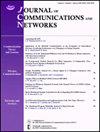The role of security orchestrator in network slicing for future networks
IF 3.2
3区 计算机科学
Q2 COMPUTER SCIENCE, INFORMATION SYSTEMS
引用次数: 1
Abstract
The traditional paradigm of connecting mobile devices over the telecommunication networks for voice communication has evolved to a myriad of novel applications with heterogeneous network requirements. The conventional telecommunication networks require a radical change to support these applications. Network slicing (NS) is one of the utilitarian technologies in future telecommunication networks to address this challenge by dividing the physical network into multiple logical networks with different network characteristics. The evolution in the applications and telecommunication networks intensifies the attention towards the security aspects. Since NS architecture is at its preliminary level, there is no security-specific element in the slicing architecture to perform security-related operations. Hence, we introduce the novel concept of security orchestrator for the NS architecture. This paper extensively discusses the expected advantages and design aspects of such a separate security orchestrator for an NS ecosystem. Moreover, the viability and the benefits of employing the proposed security orchestrator are demonstrated via a testbed implementation and relevant simulations. Finally, a set of potential future research directions related to the security orchestrator are introduced to further improve the proposed architecture's performance.安全编排器在面向未来网络的网络切片中的作用
通过电信网络连接移动设备进行语音通信的传统模式已经演变为具有异构网络需求的无数新颖应用。传统的电信网络需要彻底改变以支持这些应用。网络切片(Network slicing, NS)通过将物理网络划分为具有不同网络特性的多个逻辑网络,是未来电信网络解决这一挑战的实用技术之一。随着应用和通信网络的发展,安全问题日益引起人们的重视。由于NS体系结构处于初级级别,因此在切片体系结构中没有特定于安全的元素来执行与安全相关的操作。因此,我们为NS体系结构引入了安全编排器的新概念。本文广泛讨论了这种用于NS生态系统的独立安全编排器的预期优势和设计方面。此外,通过一个测试平台实现和相关模拟,证明了采用所建议的安全编排器的可行性和好处。最后,介绍了与安全编排器相关的一组潜在的未来研究方向,以进一步提高所提出的体系结构的性能。
本文章由计算机程序翻译,如有差异,请以英文原文为准。
求助全文
约1分钟内获得全文
求助全文
来源期刊
CiteScore
6.60
自引率
5.60%
发文量
66
审稿时长
14.4 months
期刊介绍:
The JOURNAL OF COMMUNICATIONS AND NETWORKS is published six times per year, and is committed to publishing high-quality papers that advance the state-of-the-art and practical applications of communications and information networks. Theoretical research contributions presenting new techniques, concepts, or analyses, applied contributions reporting on experiences and experiments, and tutorial expositions of permanent reference value are welcome. The subjects covered by this journal include all topics in communication theory and techniques, communication systems, and information networks. COMMUNICATION THEORY AND SYSTEMS WIRELESS COMMUNICATIONS NETWORKS AND SERVICES.

 求助内容:
求助内容: 应助结果提醒方式:
应助结果提醒方式:


